
The Nomad is a series of stories, fascinations, encounters, observations, experiences, joy of the moments by me, Ulrike Reinhard – all around my travels. Stay tuned!
Ulrike Reinhard is The Nomad 🙂
I’d heard about this Tanzania-Zambia-Railway many years ago and it was always in my mind to do this trip once. The rail line between Kapiri Mposho in the heart of Zambia and Dar es Salaam at th eIndian Ocean in Tanzania was built by the Chinese in the early seventies. It takes approximately 46 hours to travel (that’s what they say on their website), crossing beautiful landscape and for sure the promise was to see wildlife. It isn’t one of these fancy, exceedingly expensive tourist trains, it sounded much more like a real African experience.

The TAZARA train in motion 🙂
So here I was, at Livingston, Zambia, to see the water-filled Viktoria Falls when the train crossed my thoughts. I did some research on the Internet which didn’t really help much – it wasn’t at all clear if and if so when this train would run. At least I found a few phone numbers. I started calling them, besides one, no one answered. And the lady who answered said: “I am in church, please call me back on Tuesday!” Tuesday was two days later. Well, I thought, that’s a lead!
I went to the railway station at Livingston – no luck. They didn’t even knew about this train and were telling me, there is only once a week a train from Livingston to Kapiri Mposho and this train is leaving Monday eve at 8 pm. They had no idea when it would arrive. Kapiri Mposho (btw. Kapiri means small mountain) was music in my ears, because – according to the Internet – this was the train station where the TAZARA train might depart from. Yet the timing was bad. The lady from TAZARA was only available on Tuesday and the train would leave on Monday … What to do? I decided to extend my stay in Livingston and wait if I could get in touch with her on Tuesday.
There she was; I called on Tuesday morning, asked her about the train and she told me that the train will leave on Friday from Kapiri Mposho at 2 pm and let me know around noon if a ticket is available. I learned that her name was Agatha. And indeed little after noon Agatha sent me a message saying I am on! She was asking for my name and this was the reservation. She told me to come to Lusaka to pick up the ticket, there is no chance to get it anywhere else. We agreed that I’ll come on Thursday morning to her office at the TAZARA House in Lusaka. Lusaka was anyhow on my way to Kapiri Mposho, so I didn’t mind.
The plan was on – I was going to take this train on Friday! I had three days to organise everything and to reach Kapiri Mposho. I was excited. I love train rides and I enjoy starring out of the windows for hours. It’s like meditation 🙂
After the phone call I went straight to the bus station to buy my ticket to Lusaka for the following day. It was a seven hours ride (400 km) and buses were leaving every hour. I opted for the 8.30 am bus so I would reach Lusaka by daylight. The Shalom bus company was recommended at the “best” and most reliable of all – so I booked with them. It turned out though they were pretty bad – maybe the others were even worse. I don’t know. I made hotel reservations in the capitol and spent another lovely afternoon in Livingston at The Old Farmhouse – quite a fun place to eat and hang out.
Wednesday I spent the entire day on the bus. It only left around 10 am and it stopped at every tree along the way to pick up new passengers and drop others. Even though it was a so called scheduled “express” bus. After 10 hours we reached Lusaka, the sun was just setting. The bus station was a huge market place. It was packed, music was everywhere and there was hardly any space to walk. The moment the bus door opened the first guys were in offering taxi services – and of course, when you look like me you are the first target. “Mama, taxi! Mama, taxi, please!” Somehow I made my way through. Some guys I answered, others I just left alone. Too much to handle. I decided to walk. The hotel was only 20 minutes away and I felt happy to walk after the long bus ride. This part of Lusaka, a city of 2.5 million people, was bursting with life. Street shops, food stalls and mobile device sellers along the way. Some of them had megaphones out of which their offers looped over and over again. It was colourful, loud, yet not at all aggressive – lively, vibrant, daily life. I loved it.
Thursday morning I called Agatha – she replied and asked me to come to her office, second floor at the TAZARA house, room 211. The TAZARA house was very close to the bus station, I’d already seen it on my way to the hotel the night before. I walked up the stairs and found her behind a glass teller in her office. She was dressed like a business woman and looked very strict. I had to make her laugh – with a laugh in her face she looked much more beautiful. She issued my ticket – a ticket like we had in the seventies back home. It had the third of the size of a credit card and was made out of a strong carton. Beautiful in its simpleness.
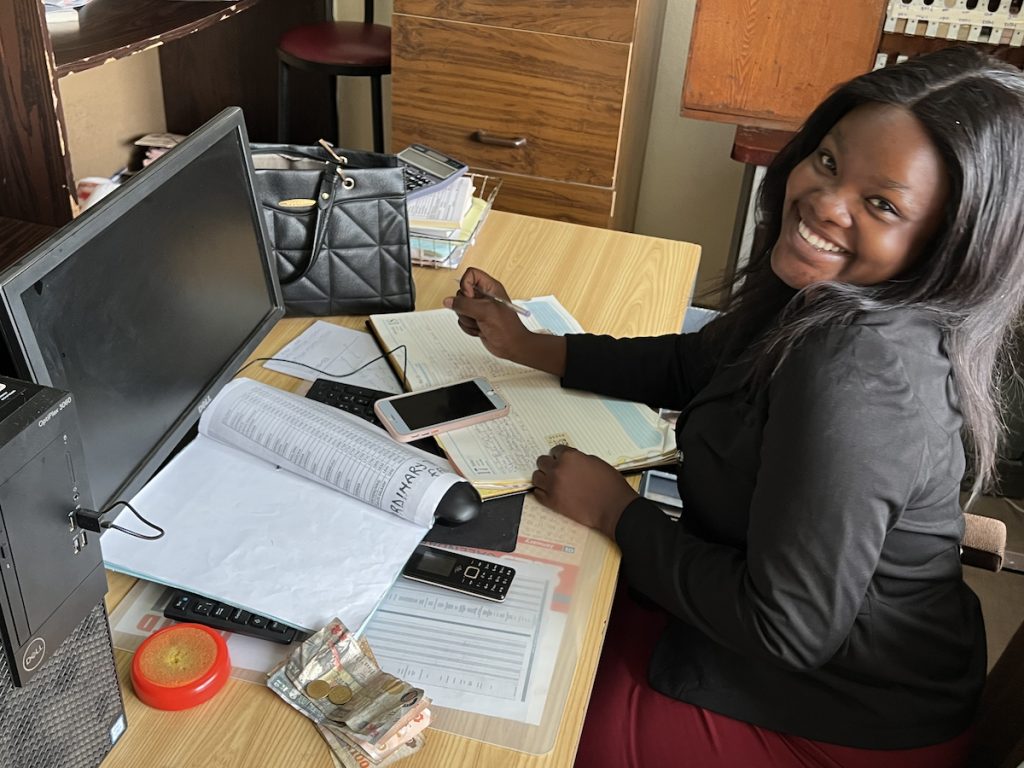
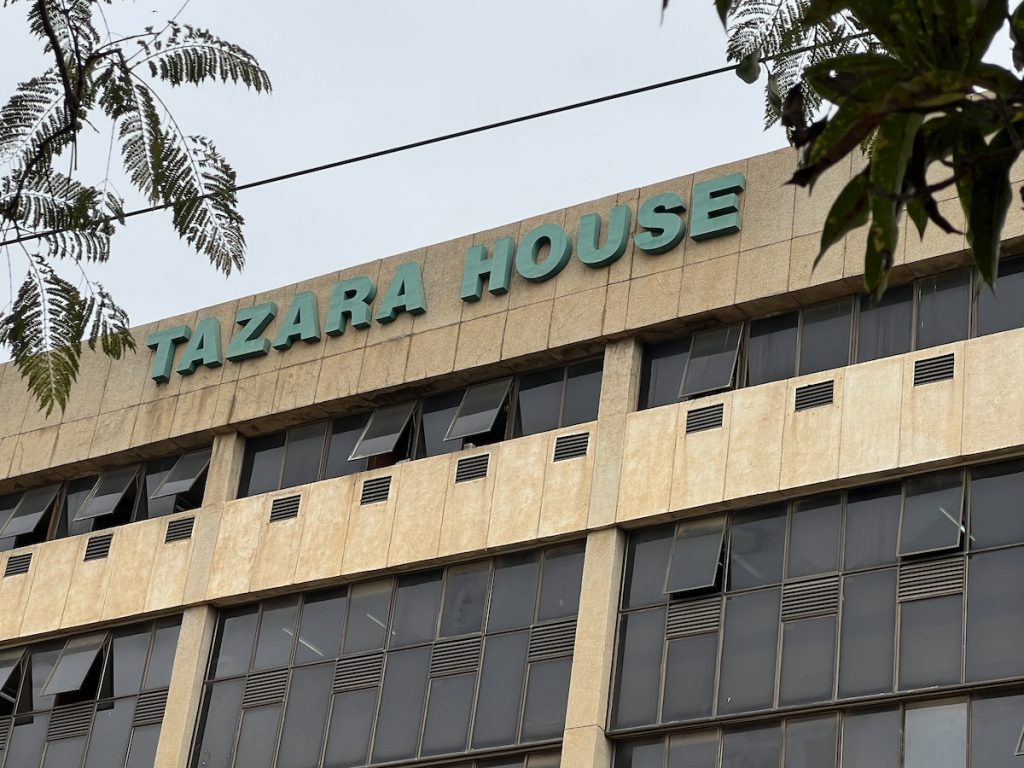
Agatha in her office at Tazara House, Lusaka, Zambia
Now everything was settled, I just needed to figure out my transport to Kapiri Mposho. I didn’t want to rely on the bus services next morning, I felt the risk is too high to get stuck and miss the train. I organised a private taxi for a reasonable price (200 km , 80 Euros); the hotel helped me to find the driver. At 7.30 am we left on Friday morning. The first 40 km out of town and suburbs were a lengthy stretch but then it became an easy drive. We were stopped twice by traffic police – a sort of organised crime. They threaten the driver, who hasn’t done anything wrong, by filing a court case against him and they immediately stop the process once you bribe them – in Namibia this bribe money has its own name, it’s called “soft drink money”; usually it is between 5-10 Euros. Mostly two police men or women are at a checkpoint, one standing behind a camera which isn’t working and the other one sitting in the police car making the deal and receiving the cash. These people are well off and its tricky to do anything against them because this corruption goes all the way up in the system. It’s just part of daily life. And not only in Zambia.
We reached the railway station at noon – I was supposed to be there two hours before departure. For what, I don’t know. But everyone was there – so I took seat in the VIP waiting room (see photo below) which is reserved for the sleeping car passengers, and waited. So did everyone else. The other passengers were curious where I came from and what I was doing here. What my plans for Dar es Salaam were, they asked. They were quite surprised that I was interested in the train ride itself, not so much in the big city on the other side. Besides myself the only “white” people were a group from South Korea, they were on their way to Zanzibar and then onwards to the Serengeti. They were all put together in one coach. Most of the local passenges were business people; one guy was dealing with used cars, he went to Dar Es Salaam to pick up a car and drive it back to Lusaka. Some women were in the clothing industry – they told me that fabrics are much cheaper in Dar es Salaam than in Lusaka. So they go for shopping. For some it was their first train ride, others take this train frequently.
The hall of the railway station was also filling up slowly – it was a colourful crowd.
The train reached the platform at 1.15 pm. It was boarding time. I was ready to go and excited like a toddler. Happy. My coach was at the far end of the train, way beyond the platform. To enter the train, even to reach the first stairs, we needed a ladder. It was quite an endeavour to climb up with the little suitcase and my back pack. One of the staff showed me “my” room for the next three days and I settled down. I had booked a first class sleeper ticket – meaning I would share the compartment with max. three other people. Shortly after a young lady arrived, she was with me in the waiting room. I introduced myself and so did she. Lilian was her name and we would share the compartment – luckily it was only the two us, no one else joined until we reached Tanzania. We both took the lower beds and stowed our luggage. The pink bedsheets were bright and the seats/beds were comfy.

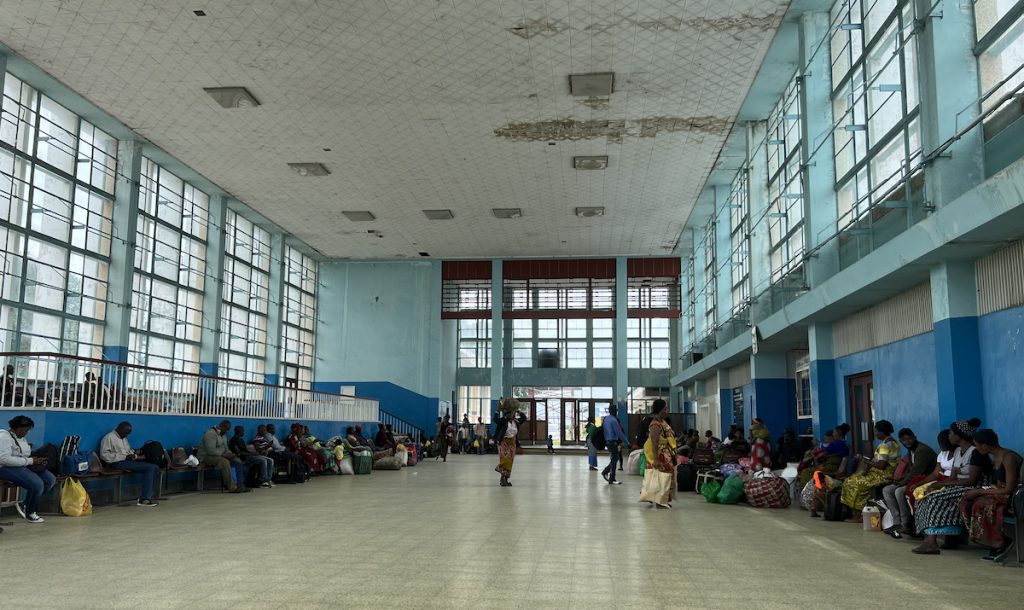
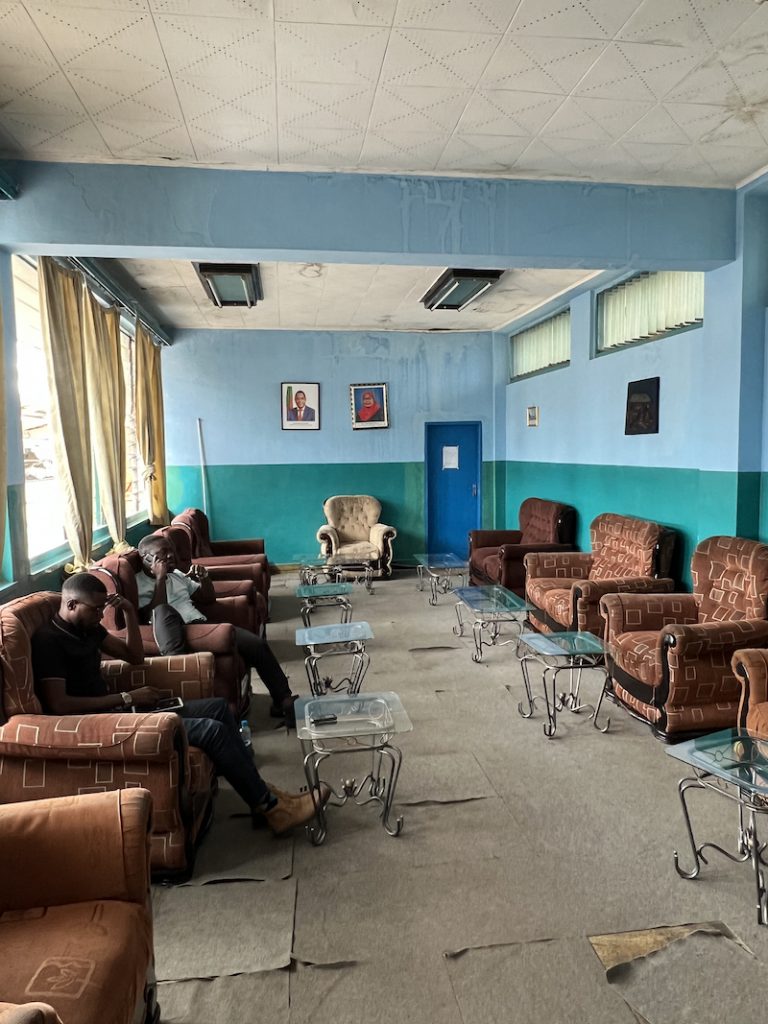
Hall of the railway station / waiting room (right)
We could open the window in our compartment to get fresh air and a cool breeze. Some horribly loud African rhythms were filling the air – the speakers were turned on full volume. We asked the staff if it is possible to lower the noise, but he said no … it’s either this or nothing. We opted for nothing, at least in our compartment. Five minutes later a technician showed up with a screw driver and a pliers to cut the line. We were happy! So far, so good.
The train left the station at 2 pm sharp with a loud horn blow. The journey began.
I deeply enjoyed the view from my bed. It was rainy season and everything was lush and green. For me looking out of the window is better than watching any kind of movie, it’s the ever-changing theatre of nature.
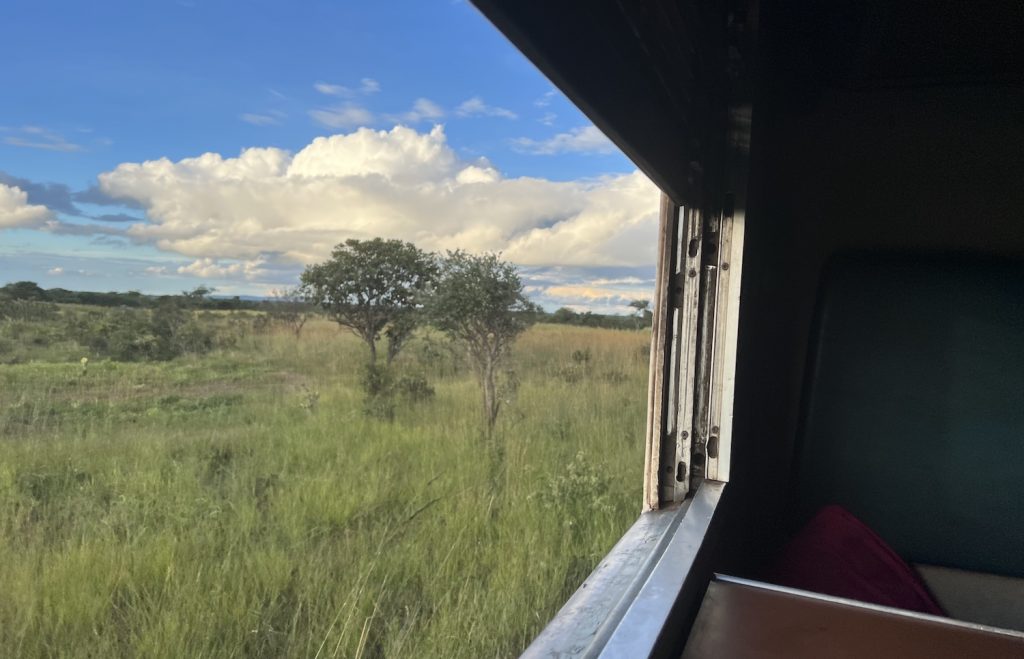
View from my bed
The train didn’t take the direct route, it went quite a bit zigzag. I was busy watching the scenery. Slowly but steadily we were rolling through Zambia’s copperbelt. In Mpika instead of going north east it went straight north into a hilly area of Zambia. Shortly before sunset we had our first “emergency” at Kasama. It rained lightly. The track section was slowly ascending over a longer distance. Suddenly a loud bang, the train “stumbled” forward with a crash and came to a halt. Minutes later the train pulled back for at least 2-3 km to Kasama Railway station where it stopped. We waited. No annoucements.
Lilian hung her head out of the window and asked what was going on. There were quite some people on the platform. They were saying that a wheel derailed further up because of the slippery tracks! Everything was wet! Yes, it was raining. For godness sake, I thought! No one seemed to be worried and with confidence they said that the technicans will repair it shortly. We waited for another 30 minutes or so and the train started again. Slowly, very slowly it moved forward. Shortly after it stopped again and rolled back. It felt like it didn’t work out. Another 20 minutes and they gave it a thrid try – and they succeeded. Our journey continued at a snail’s pace and we managed to climb up the hill. By then it was already dark.
We ordered our dinner – the choices were either chicken or fish. I opted for the chicken. I didn’t expect much and unfortunately I was absolutely right 🙂 But – I have to say – our waiter managed to safeguard the one and only bottle of white wine available on bord and he didn’t hesitate to walk up and down four coaches between the restaurant’s fridge and our compartment for the well temperatured refills! I highly appreciated his efforts and tipped him nicely. He had organized a South African Chardonnay – not bad at all. After two glasses I made my bed and went to sleep. I was happy and looking forward to our next day!
I woke up several times during the night, but I managed to go back to sleep instantly. So I was pretty “fresh” in the morning. It was still dark and I couldn’t see much out of my window. Lilian was still sleeping, once in a while I heard her snoaring 🙂 Luckily it wasn’t that loud. I opened my laptop and started to work on a talk I’ll give later in April. I made the presentation – it went fast and smoothly. Obviously the right working space! By the time the last slide of the presentation was finished, it was daylight.
We were still cruising in Zambia. I’d expected that they would wake us up during the night for border crossing. But no, the border was quite a bit away from what I saw on the map. We were going slowly and the train basically stopped at almost every village on its way. We had maze flour and rice on bord and the train staff distributed it in the villages. There, the arrival of the train is THE weekly event. It’s probably their connection to the outside world – the area north east of Kasama looked quite remote and unaccessible and the streets we saw were muddy and slippery as a result of the heavy rains.
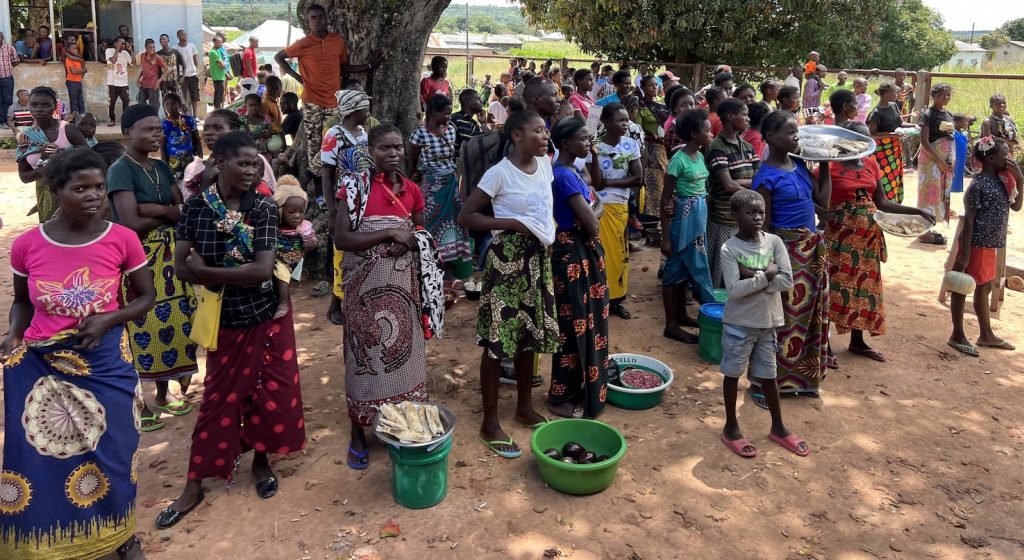
Gathering at the railway station when the train arrived
Around 7.30 am our waiter knocked at our door asking if we were ready for breakfast. I only ordered coffee and skipped the food. No, it was hot water I ordered, because there was only tea available. I got my reserve of instant coffee out of my backpack and enjoyed the “brownish water” like I would enjoy an excellent Arabica from Utengule at the Zansibar Coffee House. I was down to the basics 🙂
I’d decided to stay away from the food on the train, my stomach gave me already first signs of disturbence. I was waiting for our next halt where I was planning to buy fresh fruits and local delicacies from the ladies. Lilian was very good in interacting and negotiating with them. Their food was fresh and for sure “homemade”. No comparison to the train meals.
Before the next stop the staff came to clean our compartment. They cleaned it twice a day. Honestly, the train was surprisingly clean. Also the toilettes were cleaned a couple of times a day. Lucky us!
At our next stop we bought a green hot pumpkin and kasava, a local baked bread, from the ladies who were selling to the passengers. It was yummy.
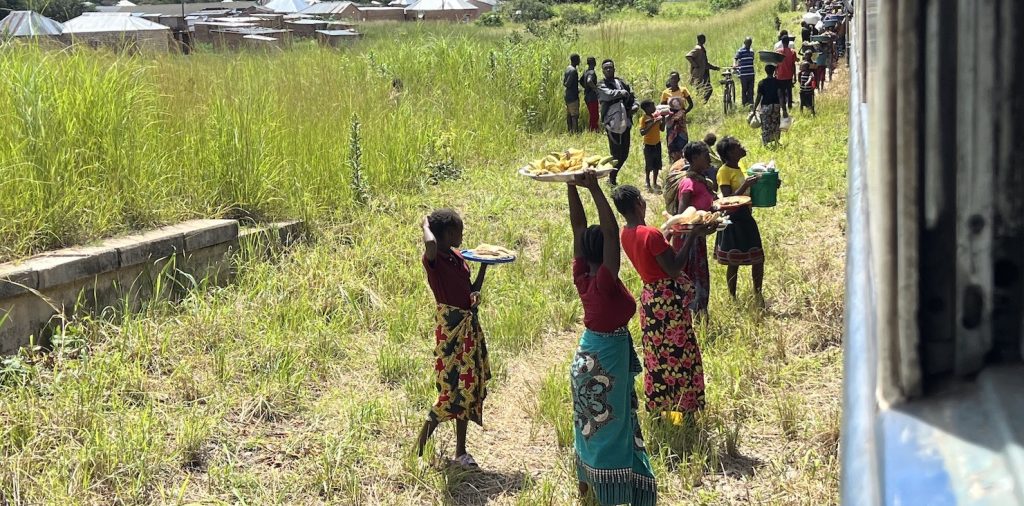
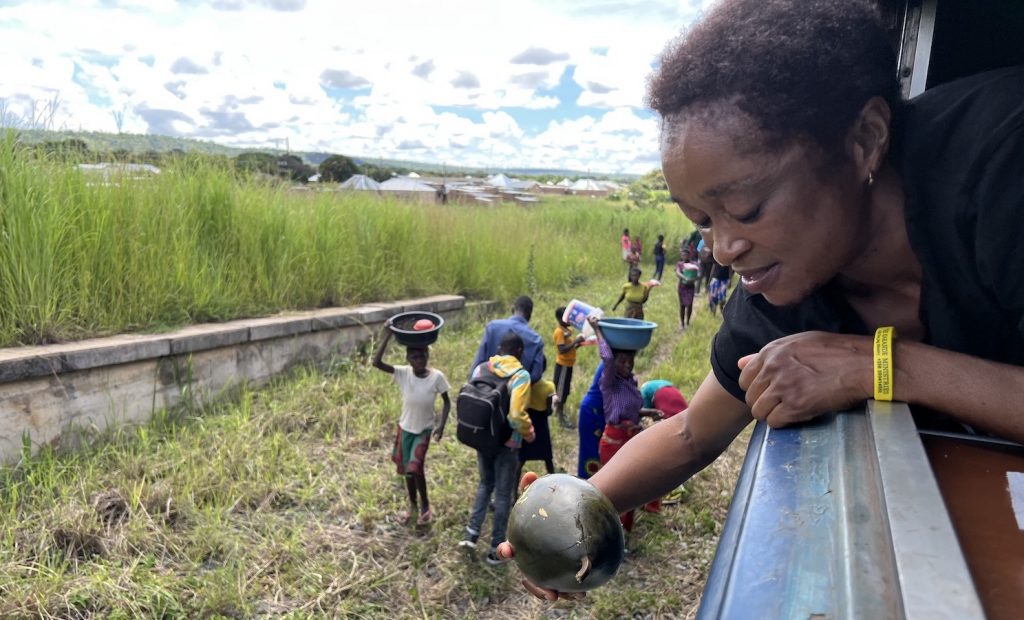
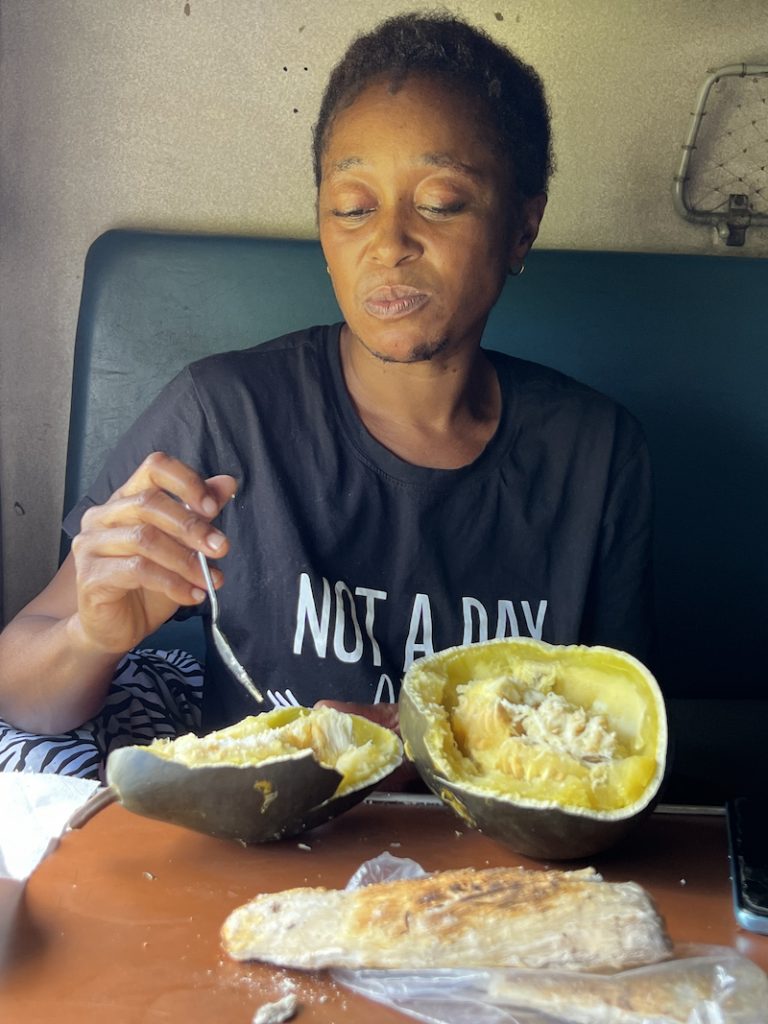
On the map it looked like we were close to the border. Yet it took us another couple of hours to reach – too many stops and only slowly we were crawling up these small hills. The train sounded like it was in pain. Every now and then there was a powerful jolt, as if for a moment the wheels stood still. At these moments you better had nothing on the table.
Finally at 3 pm, 25 hours after we started our train ride, we reached Nakonde, the Zambian side of the border. Most of the passengers departed here. Maybe 40 people were continuing their journey into Tanzania – meaning they needed to get their passport stamped, including me. We formed a line and waited in front of the closed door for the immigration officer. Finally he and a colleague arrived and – surprise, surprise – they had forgotten the keys for the “office”. Another 15 minutes later he returned and opened the door and the first passeners stepped in. It looked like a fast process – BUT! When the fifth passenger stepped in, the power went off! Power cut! The computers went down, the passport scanner was no longer working and the cameras shut down as well.
Our patience was tested.
An hour later we all were back on the train, the passports were stamped and we moved on. The next stop, only a stone’s throw away, Tunduma – the border town on the Tanzanian side. Same excercise. Everyone went off the train and walked to the immigration hall. Literally a hall. A huge empty space with two desks and maybe 30 stairs. We sat down and once again waited for the immigration officers. Once they arrived we welcomed them with a big round of applause – they were laughing and clearly got our point. It was nice.
I showed the papers for my Covid vaccine – yes, they were still controlling if you have at least 2 vaccinations – and then I stepped forward to the immigration officer. I handed over 30 USD for the visa – but he said no. He said the visa fee has risen to 50 USD and the only way to pay was in USD; they neither accepted their own currency nor did they accept credit cards – even though a machine was laying on the table. And I didn’t had any more USD.
What to do?
The immigration officer asked me to step aside and suggested to borrow USD from my friend. “My friend”, I said. “I am travelling alone!” “Ah,” he replied – “problem! You do need to pay otherwise go back to Zambia.” Well, I thought, that’s not an option.
I explained my situation to the young South Korean guide – the only in the group who spoke good English – and I asked him to ask his people if anyone could borrow me 20 USD – I would pay back in Dar es Salaam. He was very hesitant yet after a few soft nudges he stood in front of the group and spoke to them. They all started chatting at once, some were shaking their heads – I really didn’t know what was going on. I just waited. Then an older couple stepped forward, the gentleman had a 20 USD bill in his hands and he came towards me. In a cremonial act he handed over the bill with the words: “This is my gift for you!” And he smiled. So did I. I was safe.
I joined the line again and finally it was my turn. I now gave the officer 50 USD, he provided me a receipt and stamped my passport. I was the last one in line. Done!
The South Korean couple later gave me their business card, all in Korean, and I’ve my plan how to get in touch with them. They will be back home on March 30 – they will be surprised 🙂
By the time we boarded the train it was already dark. It took us almost four hours to get everything done at the borders. I was reday for the second half of my white wine and skipped dinner. I immediately felt the wine and got ready for my second and last night on the train!
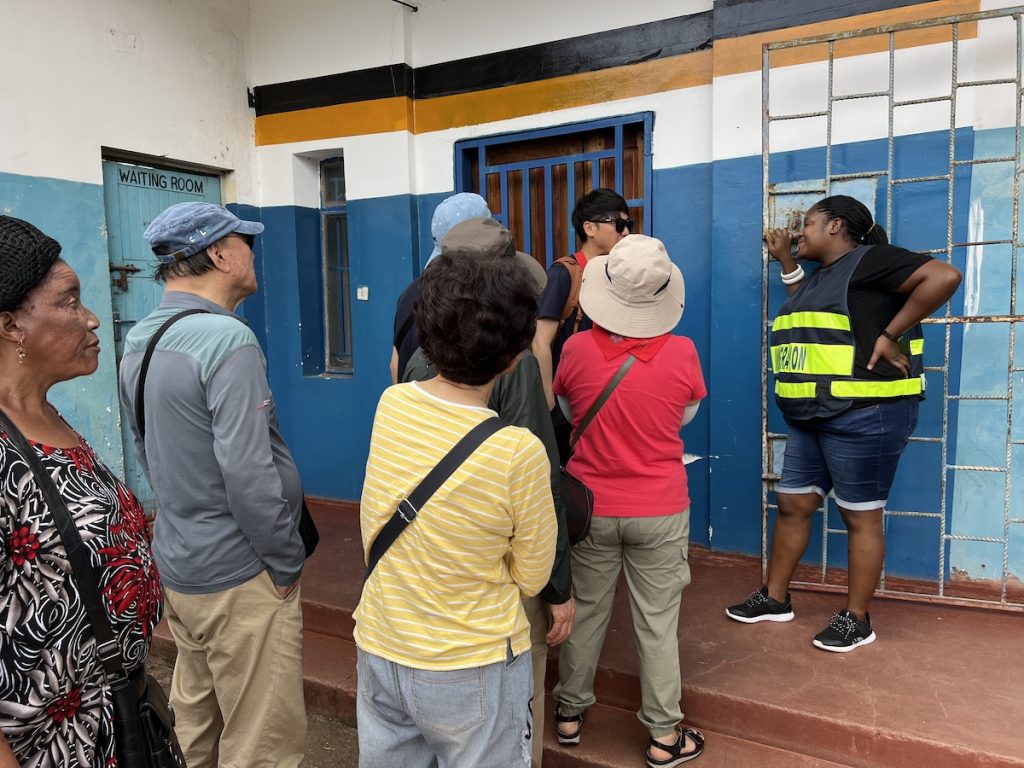
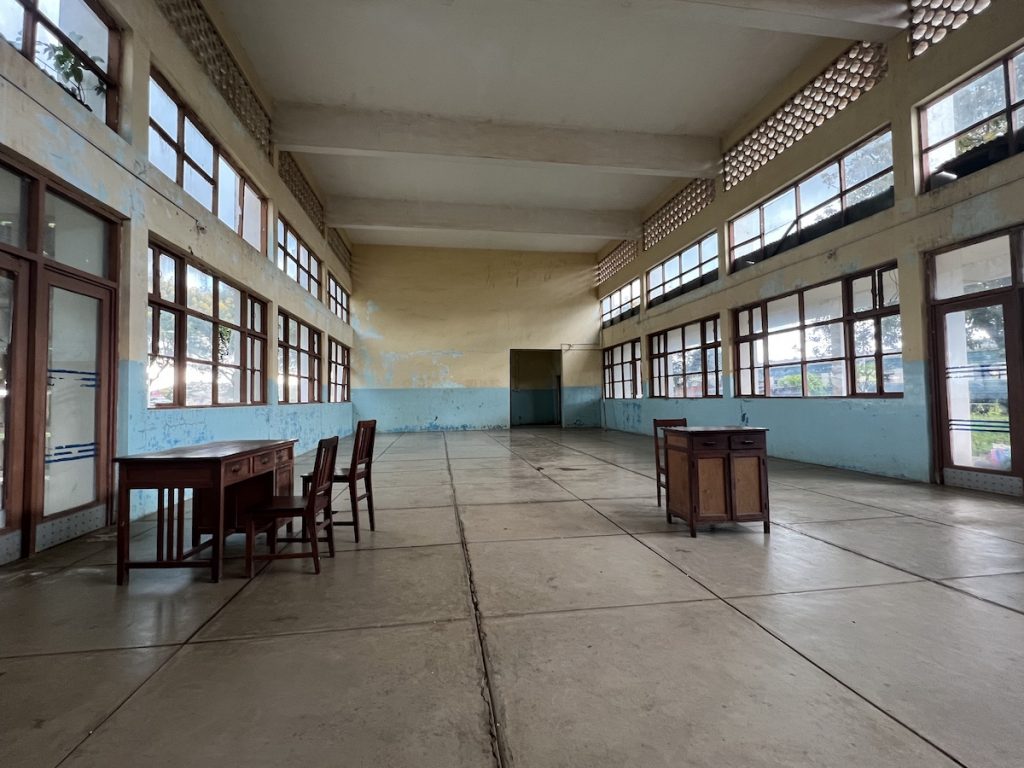
The Zambia side of the border, the immigration hall on the Tanzanian side
The next morning the landscape had changed. We were up in the mountains, it was even more lush and green, we were cruising through narrow valleys, crossing multiple bridges and passing endless tunnels. The locomotive snorted, the machines ran at full speed and we went very slow. On the map it looked like we made little progress over night. We had passed Mbeya and were now in Tanzania’s coffee region making our way north towards the Mukumi National Park.
My estimate in the morning was – just by looking at the map – that we could reach Dar es Salaam around 8 pm. I didn’t know how wrong I was. This meant to me that we would reach Mukumi during daytime – I was yearning to see wildlife from the train. People were telling me, it is amazing.
And it looked so much doable.
But we didn’t succeed. The train was struggling to make its way forward. Too many ups and downs and narrow passages. We had so many stops in these small villages along the way between Utungule and Ifakara – I felt in the evening that we’d spent more time stopping than running. At every stop goods were delivered, plenty of people got on and off the train and the ladies and children were coming to offer their homemade food and fresh fruits.
Meanwhile we had a new passenger in our compartment. A beautiful, tall, well-built mid-aged lady wearing her colourful, traditional clothes. She only spoke Suwaheli, so I couldn’t talk much with her. And Lilian was rather lazy in translating. She was going to hospital in Dar es Salaam, she said. High blood pressure. She did the journey every couple of weeks. And her estimate was, that it will take another eight to nine hours to reach the capitol. This meant we were suppose to reach Dar es Salaam around 3 am in the morning. There it went, my wish to see the wildlife in Mukumi.
And the lady was absolutely right, it became dark again way before we reached the National Park.
I had made a hotel reservation in Dar for Sunday night. I messaged them that I would come late at night, possibly more towards early morning and I asked to keep the room. No problem was the immediate reply! So, this was sorted. My plan was not to spent the early morning hours at the train station in Dar.
I woke up at 4am and the map showed we still had a bit to go. I went back to sleep until the conductor woke us up at 6am telling that we’d reached Dar es Salaam. We’d been 64 hours on the road! Wow!
I packed my luggage, said good bye to my ladies and took a taxi to the hotel. I had Lilian’s phone number and I promised to send her some of the photos I had taken. What I did.
I was ready for a shower and a good breakfast.
Even though I hadn’t seen wildlife the trip was worth every minute. And yes, it was indeed African!
Thank you!
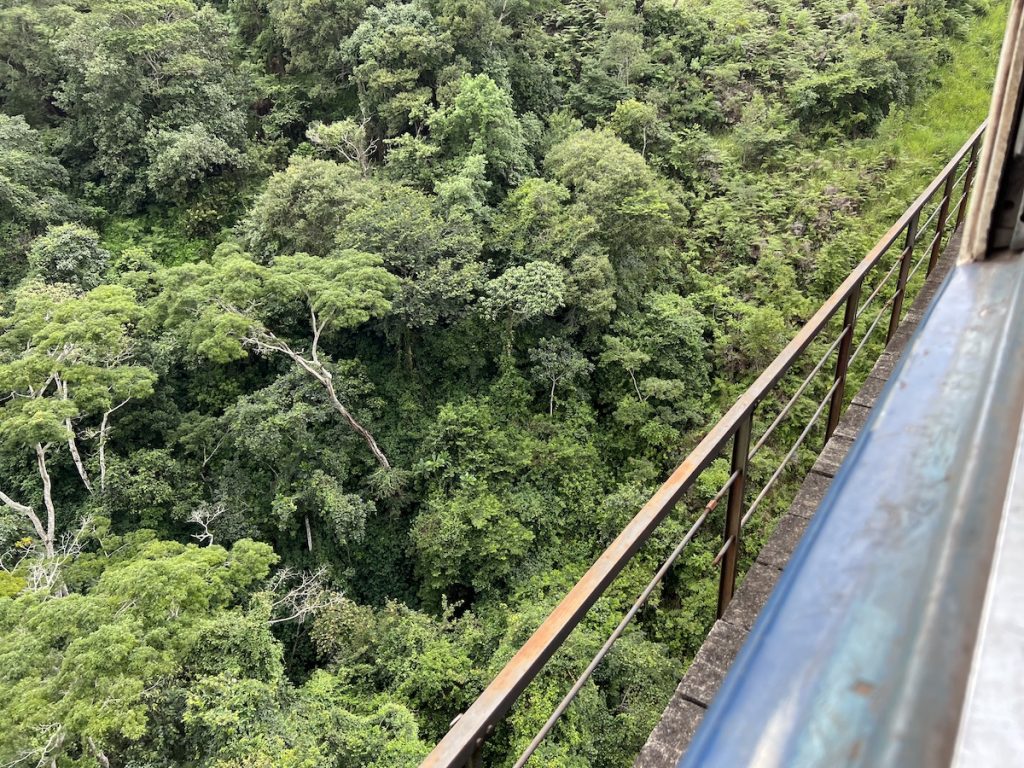
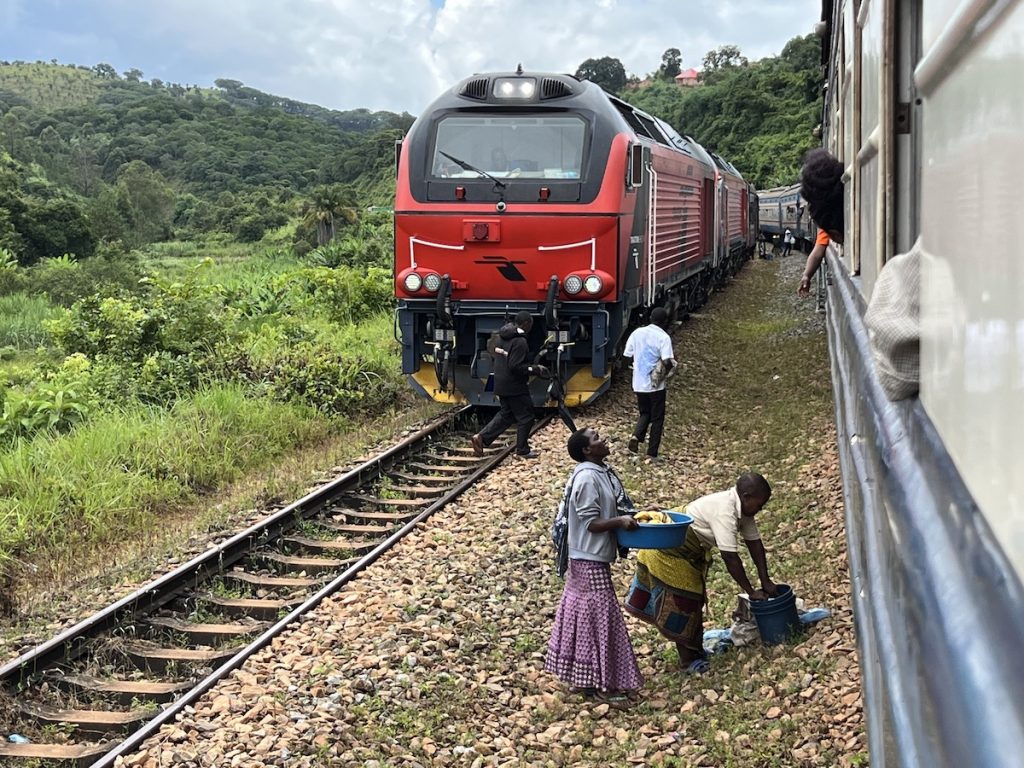
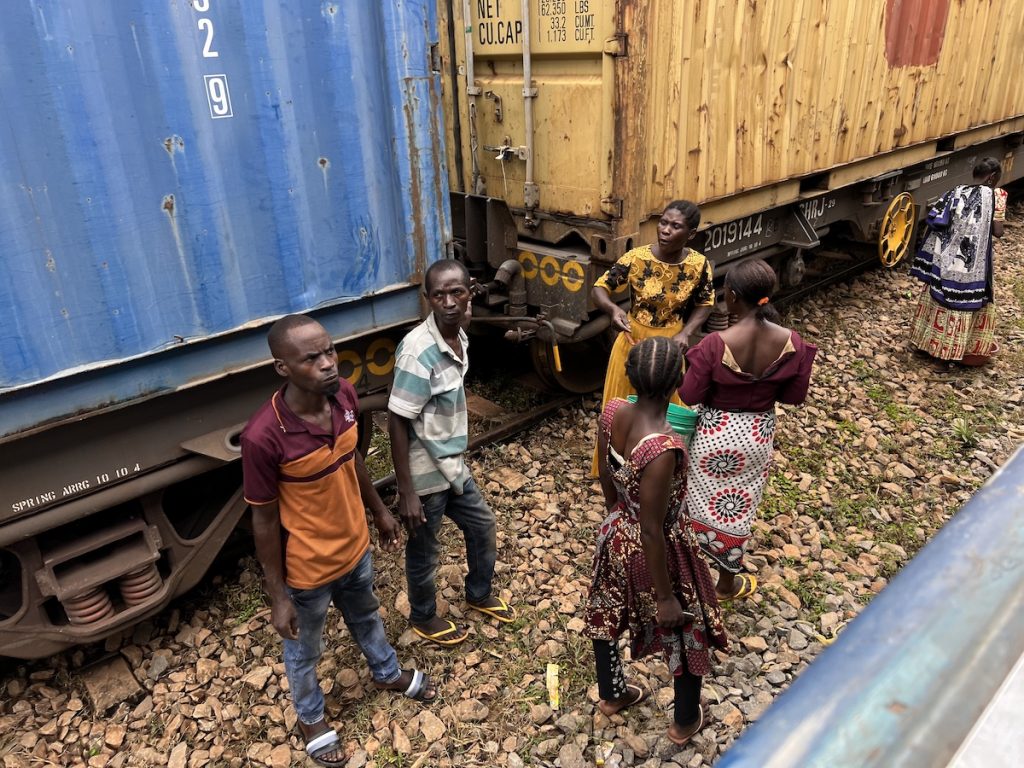
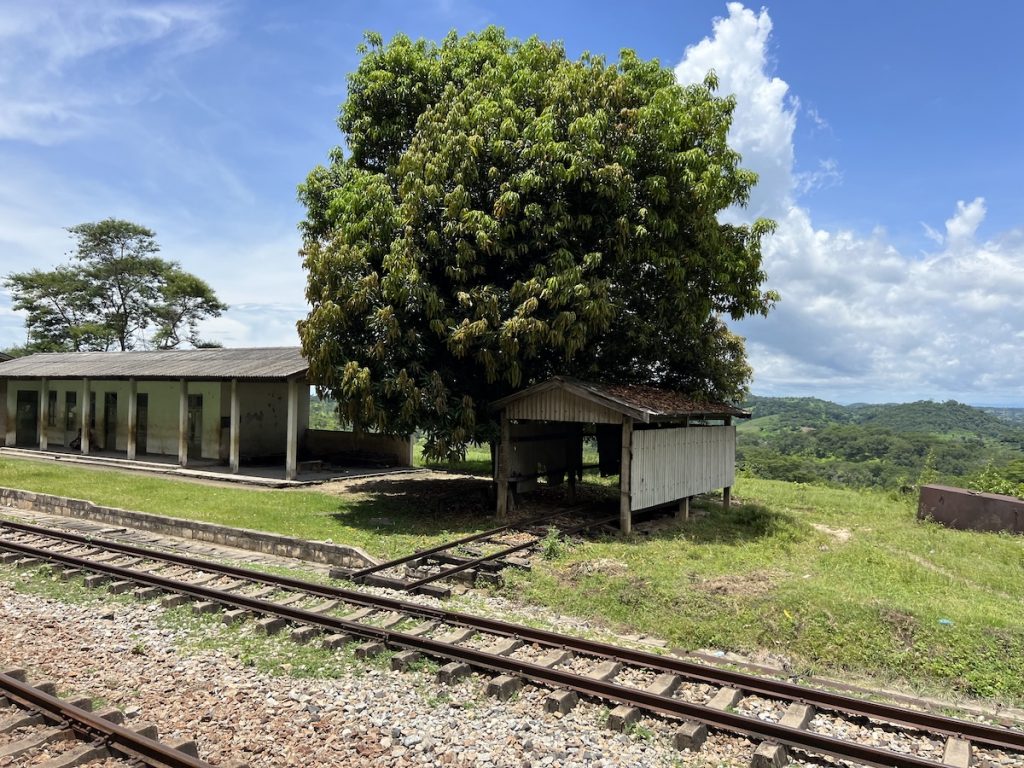
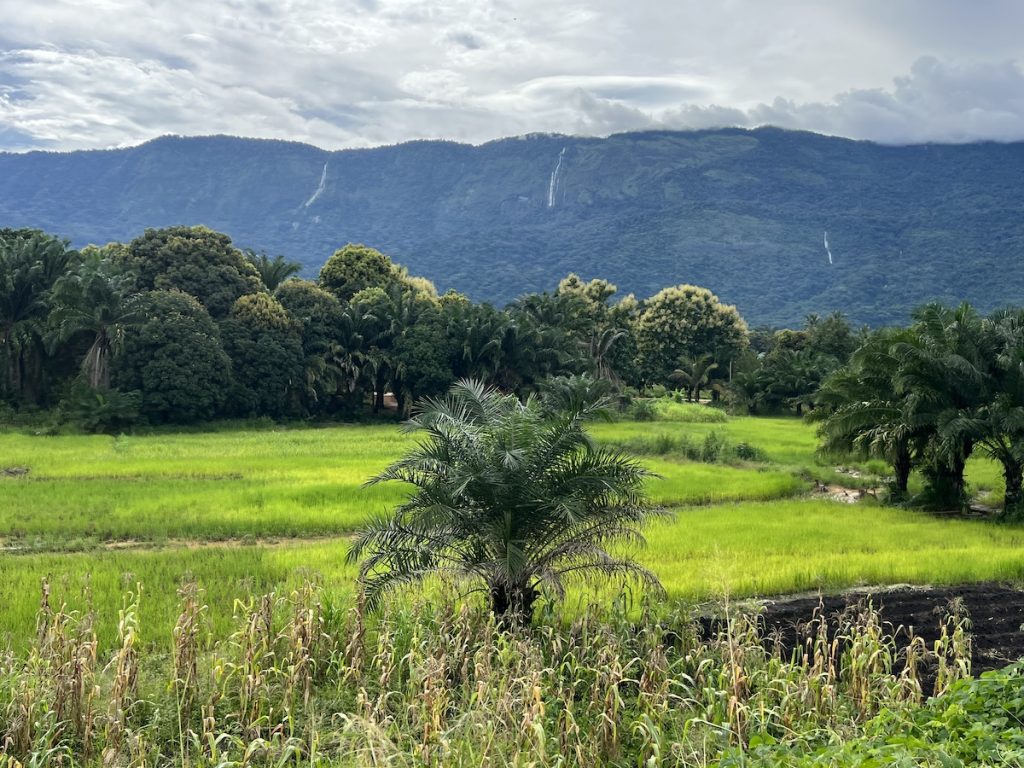
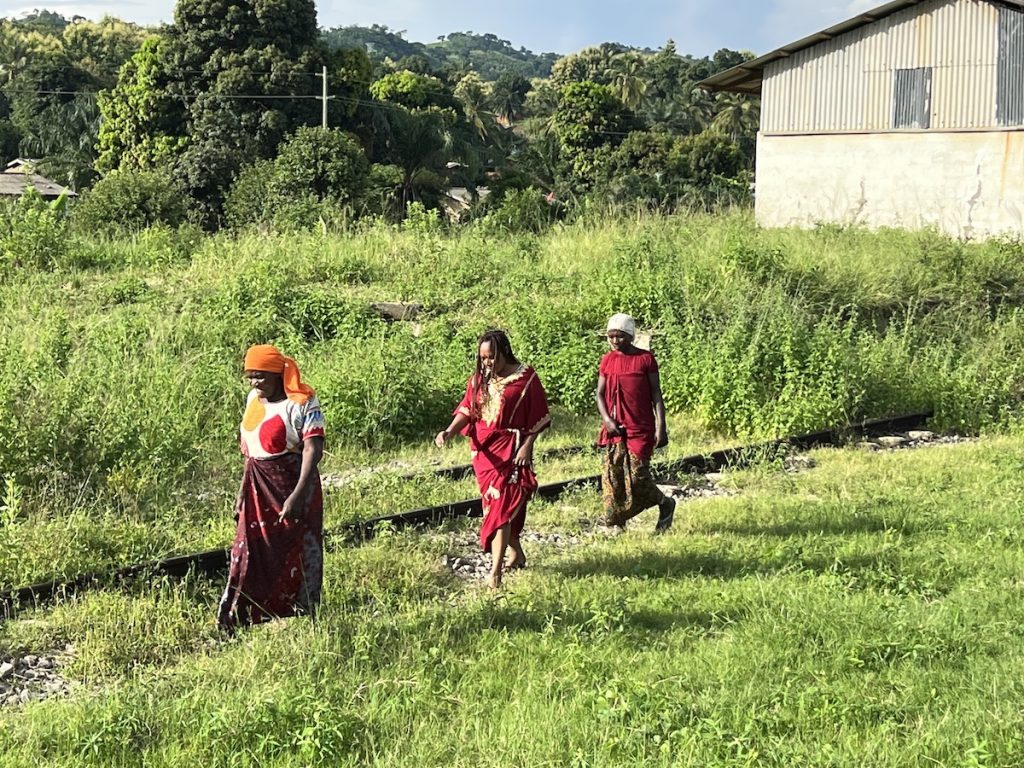
Some impressions along the tracks
What you need to know for travelling:
The route: Between Makambako it leaves the main route and goes via the remote villages and mountains along Mtimbra, Chita and Ifakara. Google maps wouldn’t let me mark this route 🙂
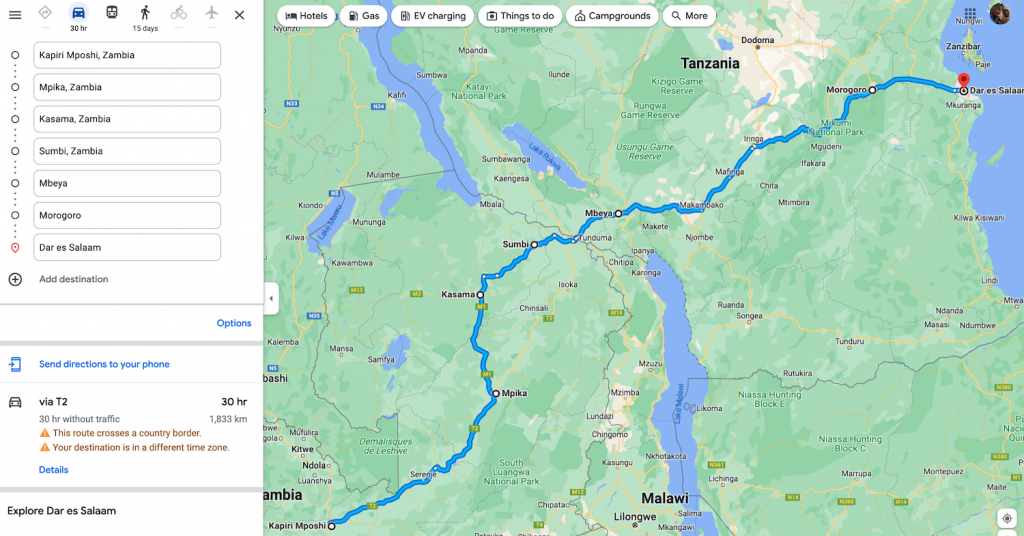
The train from Kapiri Mposho to Dar es Salaam leaves twice a week, Tuesday (2 pm) from Kapiri Mposho to Dar es Salaam and Friday (4pm) it returns at 2 pm. There is no schedules arrival time. They estimate 46 hours, my train ride took 64 hours.
Costs: 700 Kwacha (=35 Euros, 1st class, sleeper); first class means max. four people in the compartment. 2nd class are max. six people. And then there are the regular seats.
Food and water and if you are lucky even wine is available at extra cost on the train. It’s cheap.
The tickets you can’t buy online, you have to go to a TAZARA office either in Lusaka or Dar es Salaam.
To cross the border you have to leave the train twice, at the Zambia and the Tanzania side. This can take up to 3,4 hours and requires patience. Be aware if you enter Tanzania that you have USD at hand for your visa. They ONLY accept USD, no local currency.
It’s a one hour time difference between Zambia and Tanzania.


8 thoughts to “TAZARA – The Tanzania-Zambia-Railway Adventure”
Pingback: Interview about my travels – Ulrike Reinhard
Brilliant start to your blog
Thank you Tine! Highly appreciated!
hi !!
I follow u on FB
Thank you!
wow! a train journey through Africa! I always love those trains where you can open the windows. Every place you stop, you can buy the local products through the window <3
…written by a professional globetrotter. Any lay-traveler would definitely go nuts. Great to read! Beautiful views on our beautiful, colorful world. ASANTE! d.*
Thank you 🙂